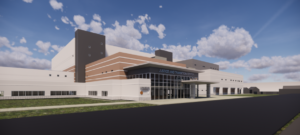Dutchess County Justice & Transition Center
Size & Cost to be Reduced
Poughkeepsie, NY… Citing New York State bail reforms and Dutchess County’s successful diversion programs, Dutchess County Executive Marcus J. Molinaro announced today the County received agreement from the New York State Commission of Correction (COC) to push back final design plan approval for the new Dutchess County Justice & Transition Center (DCJTC). The COC, recognizing the County’s productive efforts to reduce the inmate population, as well as recent state initiatives involving judicial reforms, agreed to extend the final design approval until the end of the year and consider a redesign that will significantly reduce the size and cost of the facility.
County Executive Molinaro said, “The dynamic of the criminal justice system has drastically changed with the passage of bail reform and will have a significant impact on local county jail facilities. We are grateful to the COC for allowing us to ‘pause’ in our timeline and redesign the Dutchess County Justice & Transition Center to reduce the size of the facility and save taxpayers millions of dollars.”
New York State bail reform initiatives go into effect on January 1, 2020, and are expected to have a major impact on local county jail populations as individuals charged with misdemeanors and non-violent felonies will no longer be remanded to jail in most instances. Currently, the majority of the individuals in Dutchess County Jail are awaiting trial. Under the new legislation, most of these individuals would be issued an appearance ticket rather than being sent to jail by the courts.
County Executive Molinaro, along with representatives of the Department of Public Works and members of the Dutchess County Sheriff’s Office, was in Albany yesterday to meet with the COC to review the final design plan for the Dutchess County Justice & Transition Center in accordance with the timeline agreed upon by the County and COC. That timeline called for design approval this month (May), with construction to start in fall 2019 and final completion in December 2023.
With the COC ready to approve the final design plan, County Executive Molinaro pushed for an extension to continue the analysis of bail reform impacts and redesign the plan to reduce the new facility’s size by approximately 100 beds. The reduced size is based on a comprehensive analysis of the Dutchess County Jail population undertaken by the Dutchess County Criminal Justice Council (CJC). The CJC has been reviewing the impact of the County’s various alternatives to incarceration efforts and the RESTART program since 2016. That analysis has been expanded to review how bail reform will impact total jail population numbers.
The reduced facility size is anticipated to save the County as much as $8 million in construction cost and, more importantly, reduce annual operational costs by as much as $2.5 million.
Gregg Pulver, Chairman of the Dutchess County Legislature, said, “This is great news for Dutchess County, and I applaud County Executive Molinaro for continually focusing on building a better, smarter, more efficient facility that will work to rehabilitate those in the criminal justice system. I’m happy the Commission of Correction has recognized the efficacy of our programs to reduce recidivism and will allow us to present a new plan to best deliver them.”
Dutchess County Sheriff Adrian “Butch” Anderson said, “We have established an excellent relationship with the COC and they have been a collaborative partner throughout this process to design and build the Dutchess County Justice & Transition Center. We look forward to continuing to work with them to adjust to the changing landscape of the criminal justice system and build a facility that best serves the needs of Dutchess County.”
The size of the Dutchess County Justice & Transition Center has been an evolving process since County Executive Molinaro first proposed the plan to address the County’s long-standing and costly issue of housing out inmates due to lack of capacity. The County Legislature approved design and construction funding for a new facility in 2016. While the COC originally sought a 620-bed or larger facility when the County jail’s population was reaching as high as 550 inmates, the County’s successful efforts to reduce jail population through its robust alternatives-to-incarceration program, the addition of the RESTART program, as well as mental health intervention services including Mobile Crisis Intervention Team and 24/7 Stabilization Center, have all enabled the County to reduce the planned facility’s size. The current DCJTC design plan, reviewed with the COC yesterday, called for 384 new housing beds, 100 beds from the existing 1995 jail, and 35 medical/mental health unit beds.
With the current jail population average steady at approximately 350 daily inmates, it is believed the County can reduce its design plans significantly. The COC recognized a smaller facility is warranted based on the County’s initial analysis of the bail reform impact and agreed with County Executive Molinaro that the County’s work warranted an extension until November 2019 for a redesigned plan. That plan is expected to remove two housing units from the proposed fifth floor of the new DCJTC and would no longer utilize the 1995 facility for inmate housing. The 1995 facility will continue to be utilized for administrative functions and correction officers’ facilities as planned, but its housing units are hoped to be re-purposed to address the growing need for mental health beds and transitional housing. The County would also have the flexibility of utilizing the 1995 building should inmate population change in the future.
Dutchess County Comptroller Robin Lois, who has been carefully monitoring the planning and construction of the Law Enforcement Center, met with the County Executive this morning for an update on the COC’s decision. Comptroller Lois stated, “As someone who has always been concerned about the vast scale of the Jail project, I am optimistic that a smaller initial design will allow the County to more accurately assess its future needs. Having the flexibility to adjust to potential changes in the jail population, with the ability to utilize the 1995 building as a safety valve, is a very important factor. This new approach also allows the County the time to continue to invest in our alternatives to incarceration programs that are proving to be successful, while assessing the effects of recently passed legislation on bail reform.”
The Comptroller’s recent audit of Project MORE demonstrated the value of the County’s current investment in alternatives to incarceration and other efforts. Project MORE is the County’s partner agency for delivering the RESTART program, as well as the successful Women’s Reporting Center and CTC housing, all of which are expected to be expanded with the new DCJTC.
For more information on the County’s DCJTC planning, alternatives to incarceration programming and the Dutchess County Criminal Justice Council, visit www.dutchessny.gov


